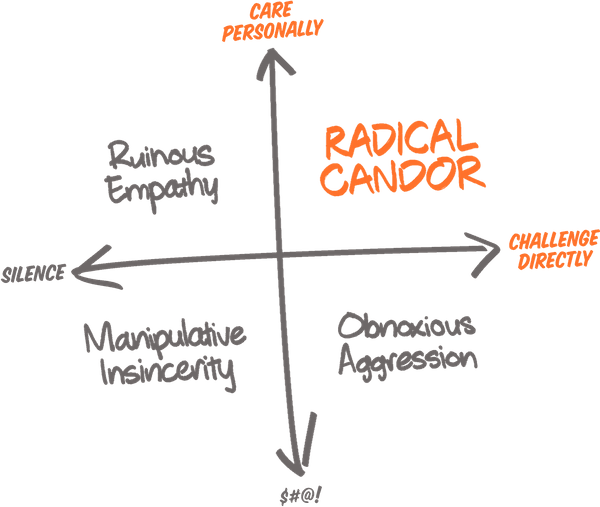
The content in this book is superb and critical for any leader. The delivery of that content could have been a bit better. So I found this book well worth reading, but I also had to re-read many parts of it, as I often found myself tuning out (either due to slightly sloppy writing or because some of the content felt like filler to pad out the book). If you’re short on time, you can find some of (but not all!) the most important content from the book delivered much more effectively in this 30 minute talk.
Here are some of the key takeaways I got from the book:
Care personally, challenge directly
-
Care personally:
- If you want people to accept and act on your feedback and if you want them to reciprocate and provide genuine feedback to you, then they have to trust you and believe that you care about them.
- “Be professional” does NOT mean you should act like and treat everyone like an automaton.
- You should care. All business is personal. All business depends on relationships.
-
Challenge directly:
- We are often told that, if you have nothing to say, you should say nothing at all.
- It turns out that as a leader, this just isn’t true.
- You absolutely must be able to deliver criticism (and praise!) for a team to succeed.
- That means you have to challenge people directly and provide clear (not mean!), honest feedback.
- This will work so long as you keep the care personally aspect in mind!
-
Example:
- “I can see you really love your dog, but if you don’t discipline it’s going to get killed.”
- The first part is the “care personally” bit.
- The second part is the “challenge directly.”
Visualizing radical candor

- Obnoxious aggression: bottom-right corner. This is where you challenge directly but don’t care personally. That is, you provide honest feedback, but you’re an asshole.
- Manipulative insincerity: bottom-left corner. This is where you neither challenge directly nor care personally. That is, you’re self-centered and either remain silent or act passive aggressively.
- Ruinous empathy: top-left corner. This is where you care personally but don’t challenge directly. That is, you’re worried about hurting other people’s feelings, so you stay silent.
- Radical candor: top-right corner. This is where you care personally and challenge directly.
Feedback
You must deliver feedback—both the praise and the criticism—so that:
- It does NOT call into question your confidence in their ability
- It leaves NO room for ambiguity or misinterpretation.
Fundamental attribution error
It’s critical to avoid the fundamental attribution error, where you focus on what someone did rather than who they are. The former is something the person can fix; the latter isn’t.
Example 1:
- Bad: “you are sloppy”
- Better: “this work is sloppy”
Example 2:
- Bad: “you are stupid”
- Better: “saying umm every 3 words makes you sound stupid”
Example 3:
- Bad: “you’re wrong”
- Better: “that’s wrong.” Or better yet, “I think that’s wrong.”
Example 4:
- Bad: “you smell”
- Better: “US culture is very smell conscious, so you may wish to look into getting a deodorant”
The job of manager or a leader is to get things done
- The way a manager or leader gets things done is through a team—which can do far more than just manager alone!
- That means the goal of a manager is to get things right; this is NOT the same as the manager being right.
- In fact, managers are often wrong, so it is essential that the team feels comfortable enough to tell you when you’re wrong!
To promote radical candor, ask for it yourself
If you want to promote radical candor amongst your team, you the leader or manager must be the first one to receive criticism (and praise!) from others. This is essential to establishing trust.
-
Ask for feedback. Ask something like, “what can I do or stop doing to make it easier to work with me?”
-
Don’t let people get away without answering. It’s very uncomfortable to criticize your boss, but it’s essential! Simply waiting in silence (seriously, count in your head to 6!) will create a pressure that often gets the person to speak up. Alternatively, prompt further, “oh, so I’m doing everything perfectly then?”
-
Ask a trusted employee. If this doesn’t work, you may have to find an employee who you trust and is comfortable delivering criticism and asking that employee to criticize you publicly. Again, this will be hard for them, but get them to do it a few times, and others may become more comfortable giving you feedback too.
-
Your goal is to listen and understand, NOT to respond. The best response when you’re getting feedback is, “thank you.” Don’t argue! After that, repeat the person’s feedback back to them in your own words to make sure you understood.
-
Reward the feedback. Thank the person and act on what they said. Make it clear that their feedback has an impact.
Praise is just as hard to deliver well as criticism
Too often, praise doesn’t sound genuine, so spend just as much time thinking about how to deliver praise as criticism!
-
Situation-behavior-impact.
- “In situation X, you did Y, which was valuable because of Z.”
- Not too effective: “Mike, great job last week!”
- Better: “Mike, great job on the new dev tooling you introduced last week; it has made builds 50% faster, which is helping us ship software faster, and makes the whole team happier.”
-
Be thoughtful of what you praise.
- For example, making a huge deal of a promotion may incentivize everyone to chase promotions and titles.
- Instead, it may be healthier to praise hard work and accomplishment far more than titles.
Share feedback immediately
-
Do not hold back until a 1:1 or, worse yet, an annual review. Waiting too long has many potential negative side effects: e.g., if you don’t praise good behavior right away, the person may stop doing it; if you don’t criticize bad behavior, the person may keep doing it and find it hard to change later; if you discuss feedback too late, the person may not even remember the original incident.
-
Instead, share feedback as soon after the event as possible. Pulling the person aside right after the event for a quick 1-3 minute chat is ideal.
-
Always prefer to share feedback live, in person. That way, you can see the person’s reaction, make sure the feedback is having the intended effect, and clarify things if necessary.
-
Praise publicly. Criticize privately. Public praise has more impact and encourages similar behavior from others. On the other hand, public criticism makes people defensive, as no one wants to look bad in front of all of their peers.
Hold meetings the right way
A big part of creating a culture of Radical Candor is holding meetings the right way:
-
Listen, challenge, commit.
- First, hear what everyone has to say.
- Next, challenge what they are saying through questions and discussion.
- Finally, make a decision and commit to it fully.
-
Ensure everyone gets an equal voice at meetings.
- Some people may be afraid to speak or always get yelled down by someone louder.
- You have to actively solve this.
- Go around the room and explicitly ask each person, one at a time, for their feedback.
- Before a meeting, ask loud people to pipe down or quiet ones to speak up.
-
Switch roles.
- In complicated debates, have the parties switch roles part way through.
- That is, if two people are arguing about a topic, force them to assume the other person’s role in the argument halfway through the debate.
- Forcing everyone to articulate the other argument ensures you fully understand that argument.
-
Obligation to dissent.
- If everyone at the table agrees, that’s a red flag, and one person must take up the responsibility of presenting the dissenting view.
Separate ideating from deciding
With difficult decisions that require lots of discussion amongst many people, there are often two competing desires:
- Ideating: get all the arguments and options out on the table.
- Deciding: pick one of the options. At this point, someone wins and someone loses.
You can improve decision-making by holding two separate meetings for complicated decisions:
-
Ideating meeting:
- The explicit goal is to discuss and gather all information about the topic but NOT make any decision.
- This meeting allows no egos and provides no winners or losers.
- The sole outcome of this meeting is a document shared with all relevant parties that contains all the relevant options and arguments.
-
Decision meeting:
- Once enough information has been gathered, you hold a separate meeting where the goal is to make a decision from amongst all the options.
It’s about what’s heard
The quality of your feedback is measured not at your mouth, but in the ear of the person receiving it:
-
The person receiving feedback is the judge. Even if you think you’re doing a great job of delivering praise and criticism, the ultimate judge is the person receiving it. If they aren’t getting the message—if they don’t feel like you are caring personally and challenging directly—then you are not being radically candid.
-
Every person is different. The approach to radical candor that works for one person may not work for another. You need to customize it to each individual. This requires building a personal relationship and understanding how that person thinks, feels, and works. Teach each person the 2x2 framework and explicitly ask where you fall on it.
Introducing radical candor
-
Get. The first step is to encourage others to be radically candid with you. Best place to do it: the 1:1 meeting.
-
Give. Start being radically candid with others. Give feedback as soon after the event as possible! Be humble and helpful.
-
Gauge. Regularly check if your feedback is being received the way you expect.
-
Encourage. Tell everyone in your company about what you’re trying to do and encourage them to do the same with each other. Make sure everyone talks to each other and does NOT merely try to bad mouth others to you.
